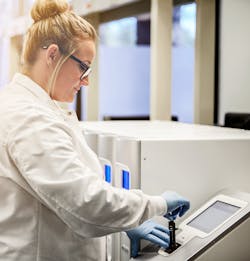New tests promise to improve sepsis diagnosis and treatment
As clinical laboratories know too well, sepsis testing is all about getting accurate, actionable results as quickly as possible to facilitate treatment selection or enable de-escalation for optimal patient outcomes. After all, sepsis represents the ultimate clinical ticking clock – given that patient mortality rates increase nearly 8 percent for each hour that appropriate treatment is delayed.1
Years ago, testing options for patients suspected of having bloodstream infections were limited to culture-based workflows, which take several days to deliver final results. Factor in the increasing importance of antibiotic susceptibility testing and suddenly, the timeline for getting high-quality results becomes virtually useless for getting patients on the optimal therapy.
Fortunately, recent advances in testing options – as well as some tests that may be on the horizon – are giving clinical labs critical new tools to diagnose patients suspected of having sepsis. The opportunities in phenotypic and genotypic testing, as well as the shortened turnaround times for results, have dramatically altered the diagnostic landscape for sepsis cases. Together, these improvements are giving physicians actionable information faster than ever and ushering in better prospects for patients with bloodstream infections.
Stages of sepsis
While sepsis can very quickly lead to death, it does follow a clear progression. Along that path, there are several points where it is now possible to intervene with testing to support better clinical decision-making.
The earliest stage occurs prior to sepsis with the precipitating infection, which ultimately triggers the out-of-control immune response that causes sepsis. Ideally, molecular diagnostics or even traditional culture-based microbiology testing would be deployed at this point to identify the pathogen and guide treatment selection in the hopes of helping to reduce the possibility that the patient’s immune system overreacts. Unfortunately, this is often not possible, as many patients are not in a healthcare facility at the time of infection, or do not know that their symptoms require a trip to the doctor’s office for testing.
As the patient’s immune system goes into overdrive responding to the infection, the next stage is sepsis, which is typically characterized by a fever and fast heart or breathing rates. Because these symptoms overlap with so many other health conditions, it is impossible to confirm a suspected diagnosis of sepsis without a lab test. Culture-based tests offered at this stage can yield that answer, but their results take too long to guide targeted treatment decisions in a timely manner. Newer testing options based not on identifying a causal pathogen, but rather on detecting proteins indicative of an overactive immune response, can deliver essential information in the earliest phases of sepsis. The most useful of these tests gives a quick yes-or-no answer, enabling a triage decision about whether the patient should be started on standard sepsis treatments.
After the onset of sepsis, patients may progress into severe sepsis. This phase is marked by organ failure and may feature decreased urination, skin discoloration, low platelet counts, and/or abnormal heart activity, among other symptoms. If severe sepsis has occurred because the standard antibiotic treatments used for sepsis have not worked, it may be an indication that the underlying infection is resistant to those particular therapies. At this stage, gleaning insight into the pathogen’s drug-resistance profile is imperative for pinpointing treatments that may be more effective. Genotypic molecular tests can produce this information far more quickly than culture-based susceptibility testing and can be deployed at this point – if not sooner – as physicians seek a more comprehensive view of the patient’s situation.
The final stage of the sepsis progression is septic shock, recognizable by extremely low blood pressure that cannot be brought back to normal ranges with medication. In this stage, mortality rates climb to 40 percent, and patients who survive septic shock may develop lifelong complications from blood clots and other problems.2 In this phase, assuming all relevant laboratory testing has been performed, physicians may reflex to guidelines that do not require lab testing, such as quick sequential organ failure assessment (better known as qSOFA), to help determine the next steps in patient care.
Testing options for sepsis
Recent innovations in diagnostic testing have paved the way for a number of new test options for patients whose symptoms are consistent with sepsis.
There is much excitement around efforts to develop a sepsis triage test that could be used at the earliest signs of illness to determine whether a patient is experiencing sepsis or not. At this stage, identification of the pathogen or drug-resistance markers is less important than getting a simple yes-or-no that would allow physicians to begin standard sepsis treatment. Promising tests in this category are typically based on host protein biomarkers such as lactate, IL-6, procalcitonin, and C-reactive protein, and offer a quick snapshot of the patient’s immune state. Triage tests are also being designed based on mRNA panels that may deliver not just a positive or negative result for sepsis but can also determine whether the underlying infection is bacterial or viral.3
Any of these tests would rely heavily on multiplexing, as evidence suggests that no single protein or mRNA would be sufficient to provide clinically useful information. Whether assays become available as in vitro diagnostics based on proprietary platforms or as laboratory-developed tests, clinical labs should anticipate running them using multiplex assay technology. This approach would provide the most information possible in the shortest period of time without requiring large sample volumes.
For more detailed information following this kind of broad triage test, rapid molecular diagnostics could identify the causal pathogen and also reveal key elements indicative of drug resistance in just a few hours. These molecular assays are generally available as syndromic panels, detecting a dozen or so of the most common bloodstream infection pathogens. Some assays are also designed to detect key markers of antibiotic resistance. Molecular assays are by nature genotypic instead of phenotypic, so some labs choose to follow up these rapid results with culture-based identification and susceptibility testing for phenotypic confirmation of the results.
An important advantage of using rapid molecular assays for patients believed to have sepsis is the ability to escalate or de-escalate treatment based on these more comprehensive results. Patients who were started on standard broad-spectrum antibiotics, for instance, may be safely shifted to a more targeted treatment, or a treatment that matches the pathogen’s drug-resistance profile. This approach promises better outcomes that align with antimicrobial stewardship strategies.
The ideal approach to sepsis testing is to deploy a combination of these tests. For example, pairing a simple triage test – whether that’s a point-of-care test based on host protein biomarkers or a conventional chemistry panel – with a rapid molecular-panel assay allows healthcare professionals to begin treatment quickly and fine-tune later based on broader evidence.
What’s next for sepsis testing
Ongoing innovation in the sepsis testing realm is cause for optimism. It should become possible in the very near future to significantly improve patient outcomes based on generating clinically actionable information in a much shorter timeframe. Any measurable reduction in mortality rates associated with sepsis would represent a major step forward in the delivery of healthcare.
References
- Kumar A, Roberts D, Wood KE, et al. Duration of hypotension before initiation of effective antimicrobial therapy is the critical determinant of survival in human septic shock. Crit Care Med. 2006;34(6):1589–1596. doi: 10.1097/01.CCM.0000217961.75225.E9.
- Sepsis: symptoms and causes. Mayo Clinic. https://www.mayoclinic.org/diseases-conditions/sepsis/symptoms-causes/syc-20351214. Accessed January 5, 2021.
- Sweeney TE, Liesenfeld O, Remme 6 M, et al. Dual-cohort independent validation of a novel 12-mRNA score for sepsis prognosis. Poster presented at International Sepsis Forum 2018, Bangkok, Thailand. https://z1f.d88.myftpupload.com/wp-content/uploads/2018/10/MKT-100019-Mortality-GSF-poster.pdf. Accessed January 5, 2021.
About the Author

Sherry A. Dunbar MBA, PhD
serves as Senior Director of Global Scientific Affairs for Luminex.
